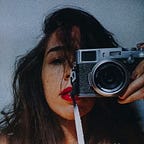Women in Photography
So far, photography is a masculine universe according to a report realized by World Press Photo, Stirling University, and Oxford University — Reuters Institute, 85% of the photographers are men. Unfortunately, this is not all, according to these 76 pages long report published in September, 23th, 2015, that investigates the state of photojournalism today; the study suggested that their situation might not be due to a lack of effort. The numbers show that these women got university education, they are more engaged with social media and more adaptable in terms of technology use, i.e. video and multimedia, and yet, fewer are being paid and employed.
According to the survey, women are more pessimistic about the future in photography. For Golden, it’s no wonder that women are stressed about their future as journalists. “We hear stories about our colleagues whose pregnancies rendered them radioactive. When clients find out, assignments dry up, it never gets much better. There are constant threats of sexual harassment and violence, often with no [Human Resources] department to appeal to. We’re surrounded by damaging and diminishing words and actions.”
Particularly, it is difficult to deal with all the discrimination suffered by being a woman, even before taking into account the professional capability. It is discouraging to see opportunities trickle through the fingers due merely to the fact of being female. Women are still a minority, nevertheless, they add and bring to photograph their distinct look. The participation of women in the history of photography is undeniable, names like Margaret Bourke-White, Dorothea Lange, or even if we look at our own history, the São Paulo photographer Nair Benedicto, all of them brought a great participation and impact on the photographic world.
“But more can always be done, says Golden. Here’s my advice to men and women on how to retain women in the field,” she says. “Support them. Make them feel valued and competent (assuming they are) and don’t dismiss them when they bring up concerns pertaining to their gender. Yeah, we all have to be tough to make it in this line of work, but women (and other marginalized groups) often have to put up with some really damaging treatment — damaging to their confidence and well-being and pursuit of happiness — and to dismiss this shows a lack of compassion that does not belong in journalism.”
They need to be always one step ahead; they always have to prove their own capacity. Lynsey Addario, famous photojournalist that in 2006 worked with women victims of sexual abuse in Congo said:
“I am a women, I am born it is a given. I have a house, a roof over my head; I have running water, electricity, education. I can decide what I wanna do for a living. That’s astonishing because for the most women in the world, they will never, never ever have one of those things. I can’t take that for granted. When I was photographing those women, they took a stand and said yes, take my picture. I want to try and give this strength to others to come forward and to not feel like they are victims. It was very clear to me that. So that I used a lot in my own experiences. I use their stories as a source of strength.”
Unfortunately, in this article, “the feminine” in photography is not as poetic as the visual language that the women’s universe brings to photography. But the strength that comes from the designated “ sex fragile” is greater than the patriarchal society could provide, and gradually leaves its marks and walks through it so one day, if the numbers are still discrepancies, it is by choice rather than discrimination.
text originally posted at OLD magazine in Portuguese http://revistaold.com/blog/a-participacao-das-mulheres-na-fotografia/
